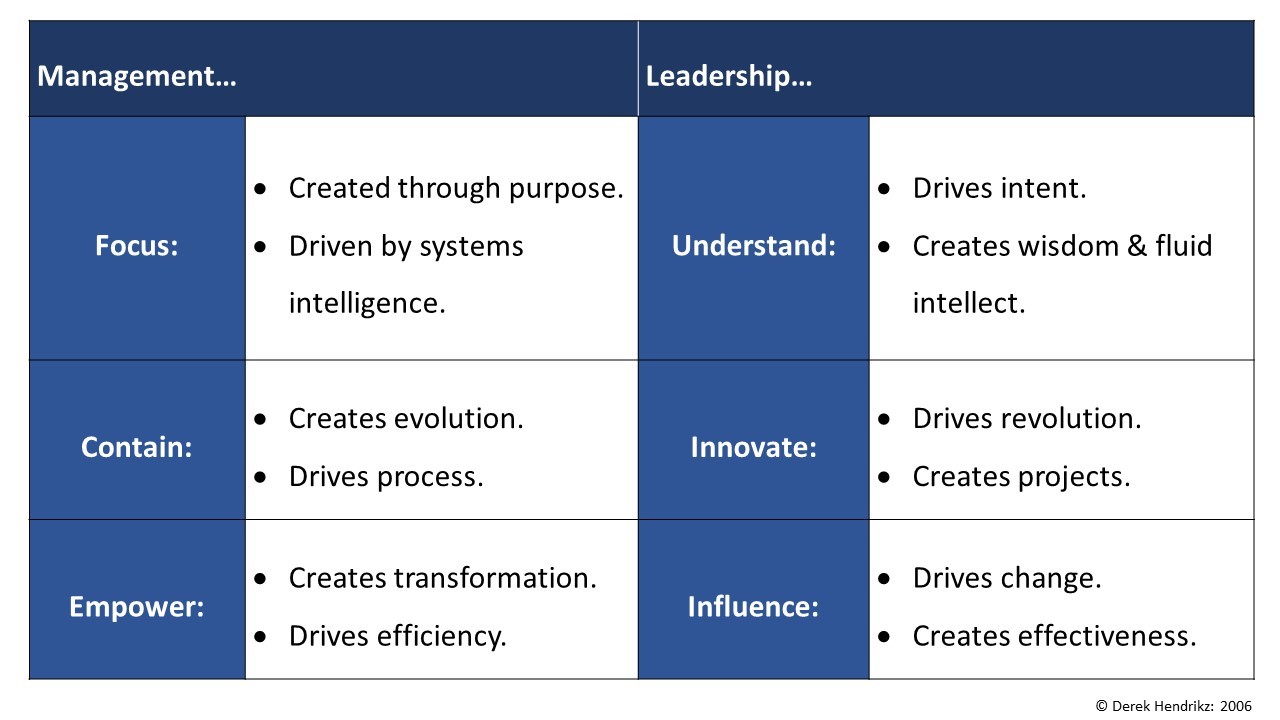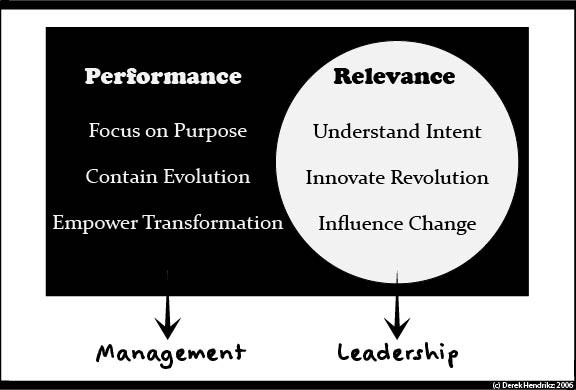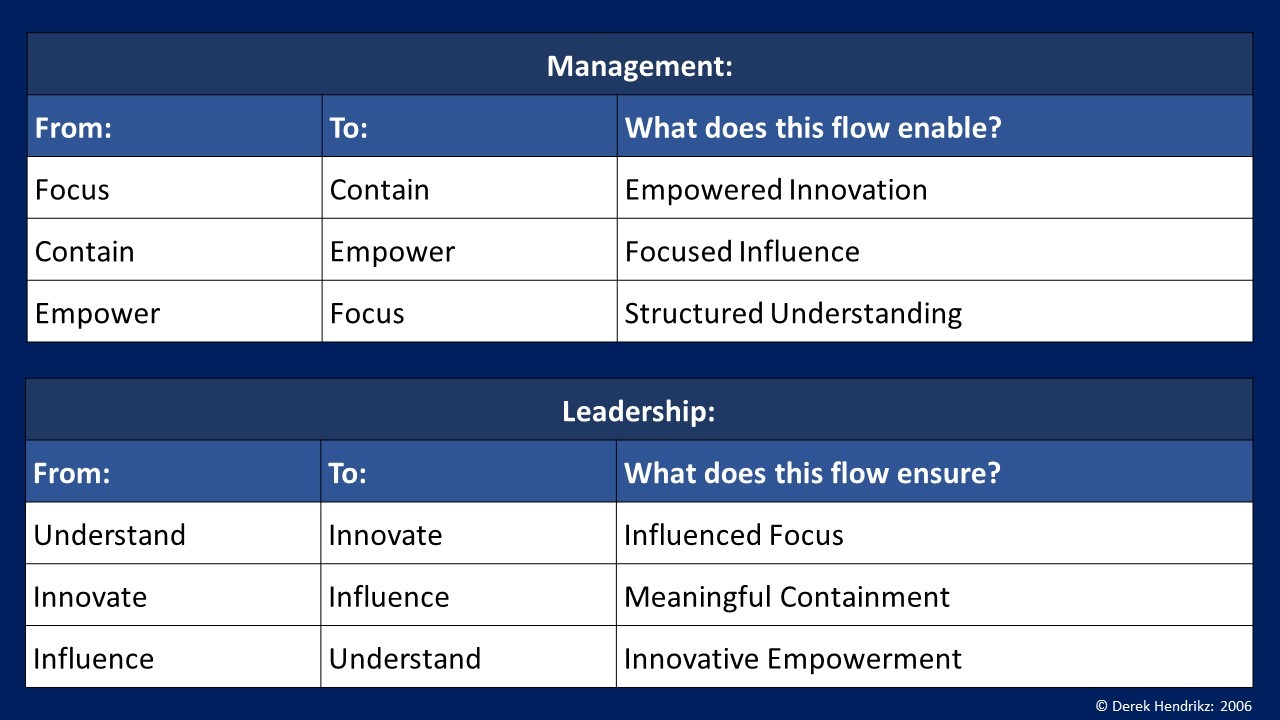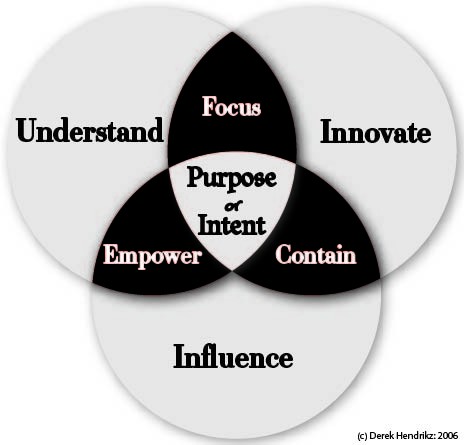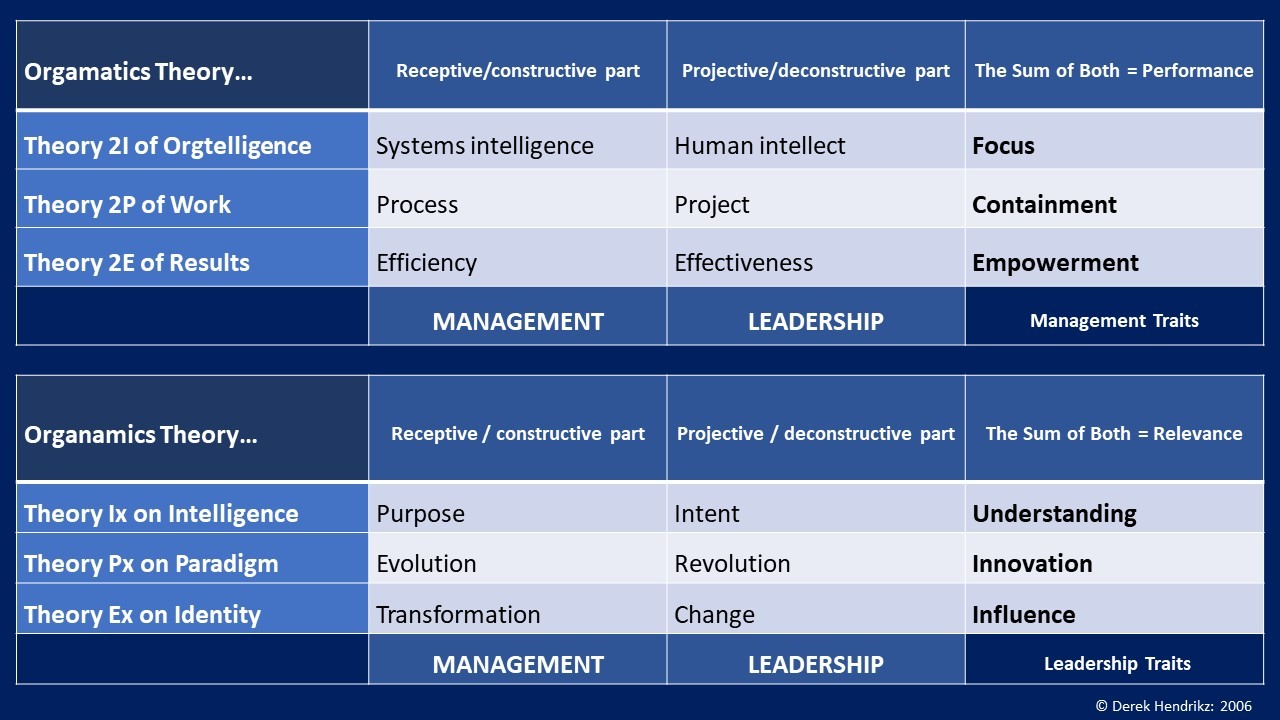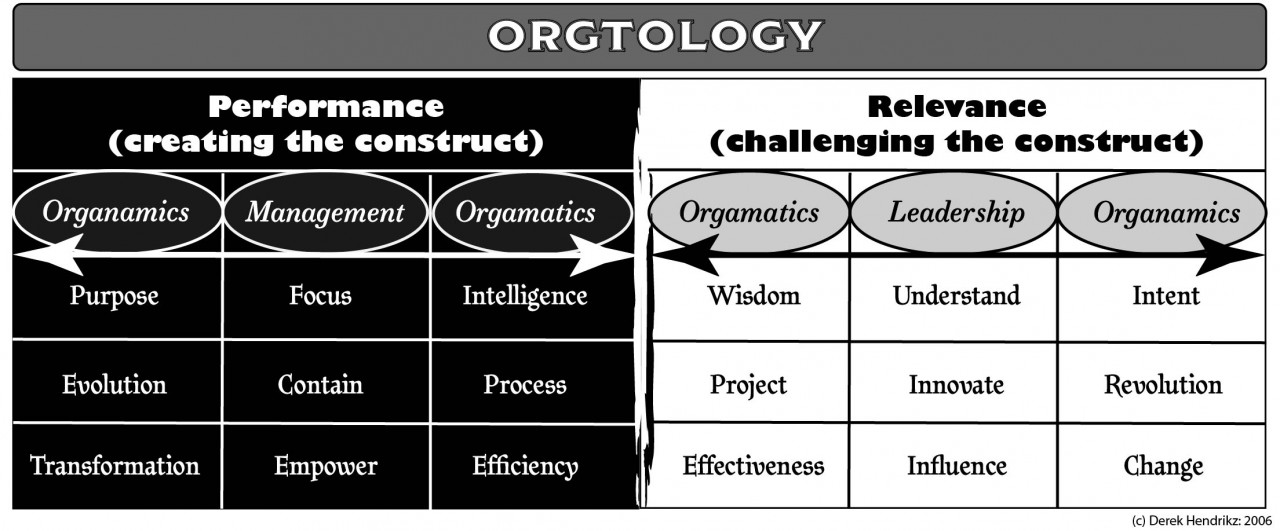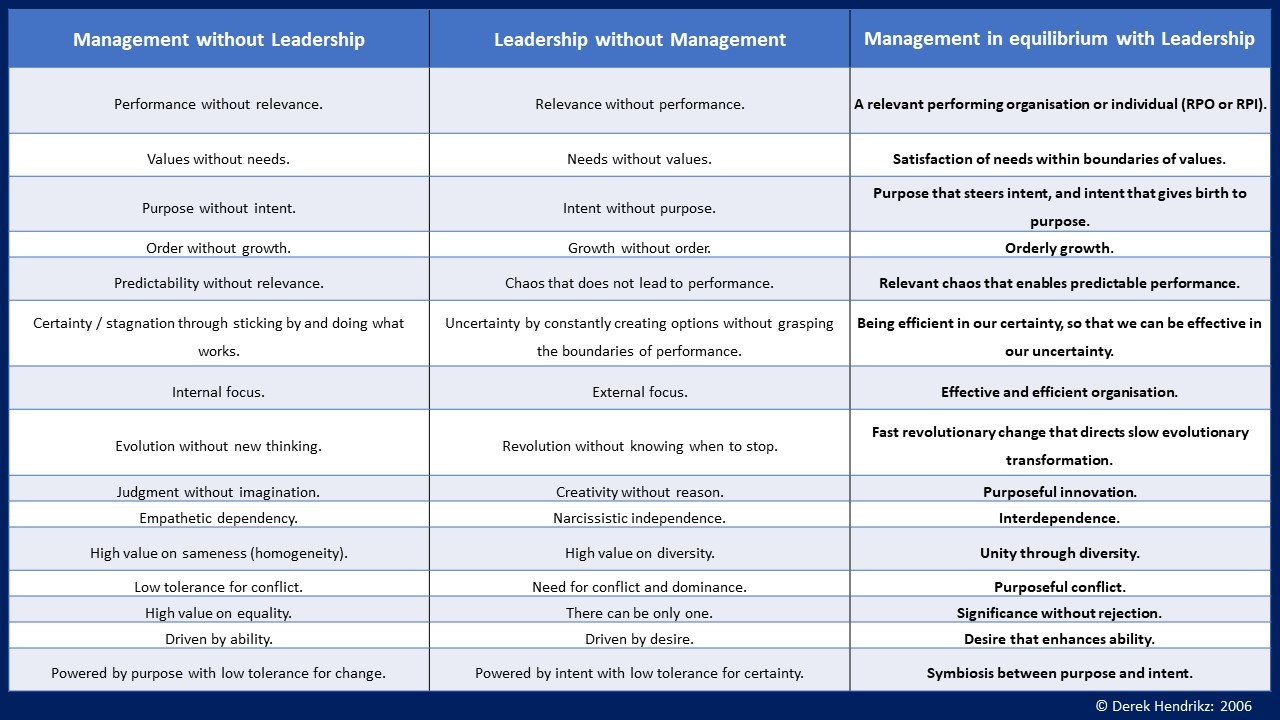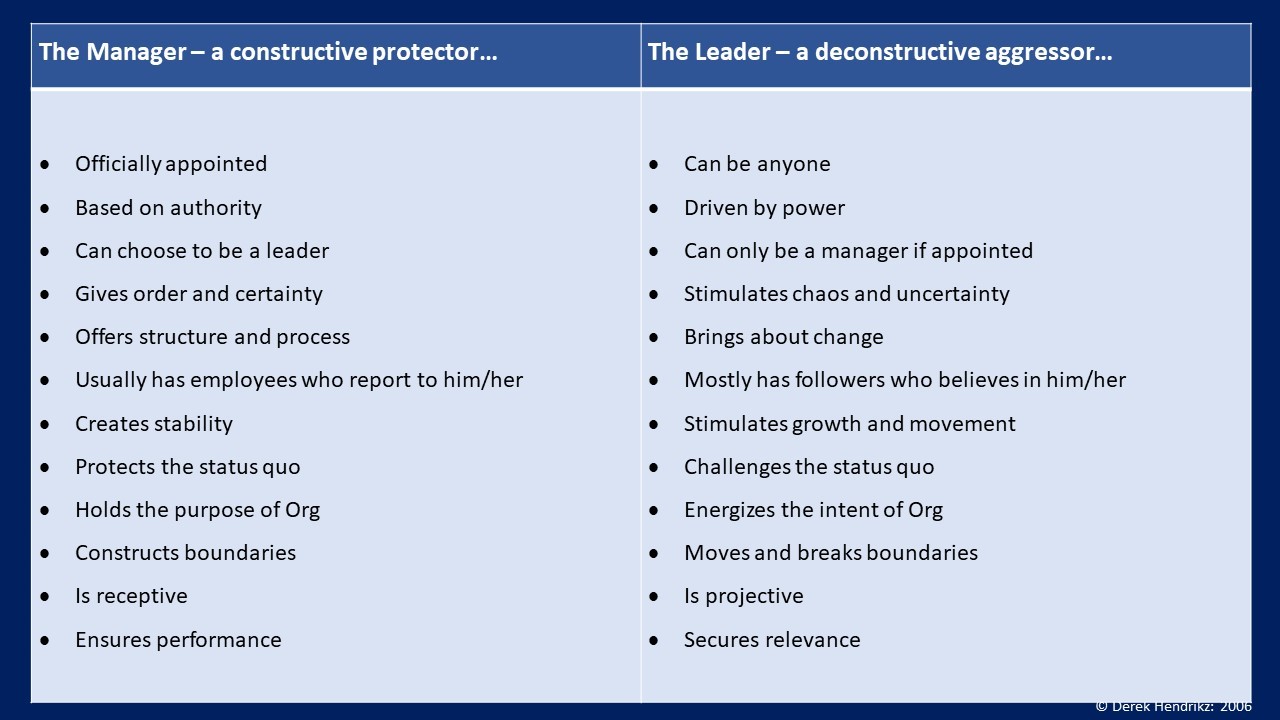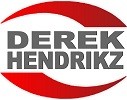The Orgtology Blog
Theory Dx – The Relevant and Performing Individual (RPI)
To perform one must manage, whilst to be relevant one must lead. In so, a relevant and performing individual (RPI) is one who knows how to manage and lead.
"On deciding when to manage and when to lead, take note of the following:
Derek Hendrikz: 2010
- A football coach is mostly never on the field, whilst the captain always is;
- The coaches work never stops, whilst the captain's work does; and
- If you eliminate either, there is no team."
The basic assumption behind Theory Dx of the RPI
If management and leadership are the two human roles that Org needs to perform and stay relevant, then a relevant and performing individual will be assessed against his/her ability to manage and lead. For any system to exist, there must be interaction between projective and receptive elements. Managers govern the receptive part of Org whilst leaders drive its projective parts. The roles of management and leadership is mostly vested in the same person. Thus, he/she must be both, relevant and performing.
In Theory Dx, the "D" stands for "dynamics", which the interaction between receptive and projective elements create. The "x" shows the unpredictability that the projective part of Org holds. Theory Dx aligns with Hypothesis 2x in that it creates an inverse relationship between management and leadership. Thus, the two create a ratio between what we do to run Org (management), and what we do to change Org (leadership).
The key components of management and leadership
To know what the key components of management and leadership is, one must understand what each must achieve. In orgtology managers run things whilst leaders change things. Thus, managers empower whilst leaders influence.
To empower means letting go of power. But to whom and what? Performance is mostly an implied thing. I.e., it is something that repeats efficiently. We make performance efficient when we give power to a process. Renowned artist, scientists, and philosophers are all masters of process. In so, managers empower processes. This begins through focusing on purpose. That is a foundational requirement for the cycle of life. Bees don't kill antelope and lions don't pollinate flowers. Through focus we hold things together, thus we contain them. Org contains all its work and resources within process flow. That is the essence of empowerment. Managers empower Org through focused process flow (efficiency). The flow of management is thus (1) focus, (2) contain, and (3) empower.
Influence is an act of negotiation, with the aim to change things. The only meaningful outcome of change is relevance. In so, leaders have the task to keep Org relevant. This begins in understanding. To change something without "knowing" is irresponsible. If one does not know what it is, how will one know what it will become? After understanding there must be redesign. That is an act of innovation. Yet, ideas only become real when others accept them. That is the essence of influence. The flow of leadership is thus (1) understand, (2) innovate, and (3) influence. Jointly, these components create intent.
What is the relationship between management and leadership?
In short, the flow of leadership will influence how you manage, whilst the flow of management will empower you to lead.
Empowered Innovation
To focus, one must give attention. This will show what the "mechanics" of something is. Through such focus one can fix small errors and know what the big ones are. Where a problem is big, a new construct will contain its solution. This flow will empower innovation. In so, efficient evolution will empower effective revolution.
Focused Influence
A construct is an idea. Contrariwise, a structure is a physical thing. Both are tasked to hold things together. Jointly they create the identity of Org. Through this identity-forming process they empower the purpose of Org. Focused influence creates the implied intelligence of Org. In so, the managers task is to empower the processes of Org to perform. There are a variety of methods to do so, e.g., targets, KPI's, reward, automation, integration, etc.
Structured Understanding
An empowered system will refocus Org through marginal increments. This is the essence of evolution because continuous improvement leads to a constantly evolving state. This is because an empowered system will consistently repeat the past with slight deviation. The deviation will be known, planned, and predicted. Through this process one can create a structured understanding of (1) what Org is and (2) the most efficient way of delivering on its purpose.
Influenced Focus
Through a structured understanding of Org, one can grasp its risks, opportunities, and/or inefficiencies. If one innovates on that knowledge, one will influence the focus of Org.
Meaningful Containment
When one influences others to accept an innovation, Org must contain it. It will do so through systems, processes, policies, procedures, etc.
Innovative Empowerment
Where leaders influence others to follow an idea or dogma, it brings new efficiency problems. To fix this, one must understand both the process and the problem. This brings balance to the transactional and transformational parts of problem solving. It creates innovative empowerment.
In turn, if you focus and contain an innovation, you empower its livelihood. If you empower and contain an idea, you will focus the way that you influence those who must sponsor it. And, if Org empowers and focuses its outputs, it will renew its consciousness which it can then contain through structure, systems, and culture.
Theoretical application:
All orgtology theories must relate to Hypothesis 2x, which is its foundational assumption. It tells us that Org exists through duality between receptive and projective elements. The receptive part of Org is constructive. It evolves through process efficiency. The task of a manager is to empower the receptive constructive part of Org. The projective part of Org is deconstructive. It re-engineers Org through effective projects. Leaders influence the relevance of Org through deconstructing old ideas and reconstructing new ones.
The table below shows how the six orgtology theories bring about a relevant and performing individual. Performance is the essential element for managers. In so, relevance is the essential element for leadership.
The Management / Leadership Crucible
"Chaos often breeds life, when order breeds habit."
Henry Brooks Adams
One part within Org must do its work, whilst another part must ensure that there is a demand for such work. This is the "Performance / Relevance" conundrum. They give meaning to each other, and in so, existence of one depends on existence of the other.
Managers govern performance whilst leaders drive relevance. Thus, the roles of manager and leader give meaning to each other. Problem is that these roles are mostly within the same person. This creates a problem because the rules and behaviour needed for relevance differs from that of performance. The one repeats a known past whilst the other takes Org into an unknown future. Both roles are vital to the survival of Org. That is the "Management / Leadership" dilemma.
The work of a leader is non-repetitive, meaning project work that has a clear goal. Therefore, it must only last for as long as needed to solve a problem; resolve a conflict; exploit an opportunity; mitigate the chance of a risk; or to avert a disaster. In so, the only aim of a leader is to fertilise performance with relevance. When this task is done, leadership must "die", so that new leadership can be "born". Inversely, managers do repetitive work. They must ensure performance without end. Therefore, a leader's role is finite, whilst a manager's is ad infinitum.
Management vs. Leadership
Below, I give a table that show the management and leadership relationship.
Management without Leadership:
Performance without relevance.
E.g., "We have a construct, which we struggle to deconstruct."
Leadership without Management:
Relevance without performance.
E.g., "We deconstruct, without assuming a new construct."
Management in equilibrium with Leadership:
Performance in balance with relevance.
E.g., "An interdependent system where we maintain a construct, which if we must, we can deconstruct and reconstruct."
Conclusion
If task of a manager is to construct and uphold, then that of a leader is to deconstruct and renew. Jointly, they enable Org to exist.
A pride of African lions beautifully displays the management / leadership relation. Picture them lazing in the sun, still digesting a carcass that they killed the night before. Cubs are playful under a strict glare of their mother's eye. Under a large old Marula tree, lies the alpha male. He is leader of the pride but does not really do much besides eat and sleep. Mostly this magnificent creature will not hunt with the females. Yet, he will eat first. Neither will he look after the cubs. Later that night, the lionesses hunt and kill an impala. The lion male hears the kill, and slowly moves towards it so that he can eat. But two hyenas beat him to the prize. Whilst one distracts the female lions, with growls and fake attacks, the other wins ground by grabbing and pulling the prey away from the lionesses' sight. As the male gets closer, he sees the threat. These hyenas are disrupting the day to day social process of the lion pride. With the blink of an eye, the lion male becomes what he was born to be. Without a moment of hesitation each muscle in his body tenses to give him the speed necessary for attack. In the run he grabs a hyena by the neck and breaks it with one rip of his jaw. Within 5 minutes, both hyenas are dead, and the lions can now willingly yield back to their process of being a pride. Whilst all this is happening, 13 000 km from there, in a New York City hospital, three doctors are preparing for a sinus operation. This is a simple procedure, in which a surgeon; an assistant physician; an anaesthetist; and 4 nurses will partake. The process is clear, since all who are there have done this a myriad of times before. The female anaesthetist starts the process by putting her male patient to sleep. The purpose of an anaesthetic in any surgery is to make the patient unconscious, so that he/she feels no pain. When fully administered, the patient's respiratory system cannot function without aid. Therefore, whilst he loses consciousness, she must insert an oxygen tube into his throat via his jaw so that he can breathe. This is a tried and tested process, and an experienced physician will barely need tacit intellect to do this. The process owns its own coded intelligence for this procedure. But, in this instance, things went wrong. The patients jaw has locked, and the surgeon cannot insert the tube. A problem has disrupted this tried and tested process, which means that implied intelligence will no more suffice. We now need a person (tacit intellect) to lead. In this instance, the best leader will be the anaesthetist. She knows this world well and has plenty of experience. The patient is turning blue in his face, which means there is no time to waste. Democratic discussion and communication that will not hurt the feelings co-workers could cost the patient his life. With an authoritative voice, the anaesthetist orders a nurse to get the tracheostomy kit. This kit will aid her to make a hole that goes through the front of his neck into his windpipe. She can then insert a breathing tube so that he can breathe. The other doctors and nurses dependently follow her instructions until the situation is under control. As the patients breathing normalises, and the anaesthetist tidies up the wound, the team slowly concedes leadership back to the process. In all the instances above, leadership was only necessary where a problem rose. In lack of a problem, opportunity, or risk, the process will steer all activity within purpose. Therefore, it is preferable that we manage most of the time because this shows that our processes work well. But where such process cannot work on its own, we will need leadership, which must always be a temporary intervention.
Now the thing about any team sport is this. At that precise moment, where the referee blows his whistle for the match to start, the coaches power drops from 80% to 20%. Whatever happens on the field, now mostly depends on the captain and his team. The coaches work is hugely process-based, and it never stops. Before the match, he must get the players to become fit, develop game plans, arrange logistics, etc. After the match he must plan again, review schedules, shuffle players, and so on. The captains work is much more non-repetitive and has a precise beginning and end. It is common that the true test of any team's captain, is the result of a match. When they play, time is against the team, and each move becomes vital towards success. Therefore, where we assume a captain to be the leader and a coach to be the manager, the coach will hold 80% of the power, whilst the captain will have 20%. This is off the field, of course. During a match, this relationship will reverse and increase the captain's control from 20% to 80%; but when the final whistle blows, the captain's power will, once more, go back to 20%. Jointly they create a binary system, where one part must empower performance, whilst the other part must influence its relevance. As with the caterpillar and butterfly, they are an inverse duality. They enable each other.
In Org, we do not have the luxury to physically split these roles. It therefore boils down to an ability to know when to be on the field, and when to step of. When something is both urgent and important, you are on the field and a leader. In this case, success is born from obedience and dependency. On the other hand, where something is important, but not urgent, you are off the field and a manager. Here success is a matter of empowering a process.
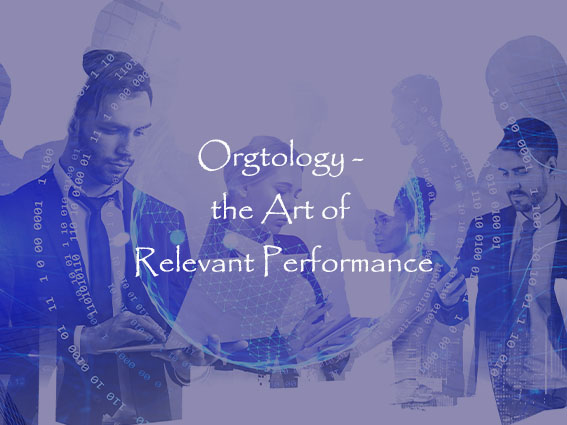
Join the Orgtologist Certification Program (OCP) - Empowering Executive Teams Worldwide
Copyright
© Derek Hendrikz: 2020-08-22
When you subscribe to the blog, we will send you an e-mail when there are new updates on the site so you wouldn't miss them.


